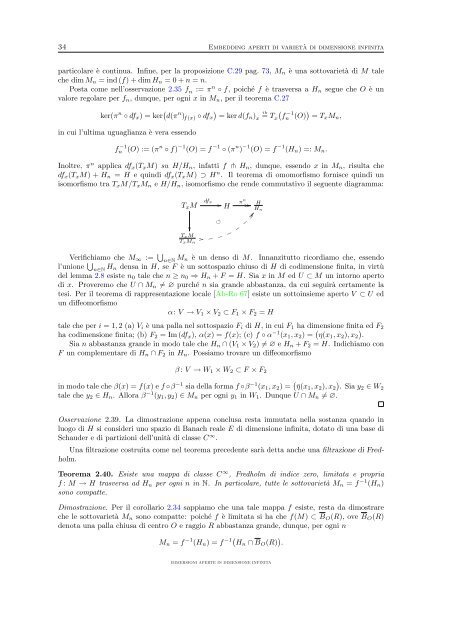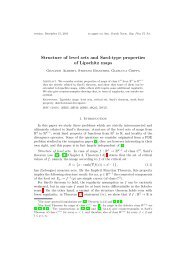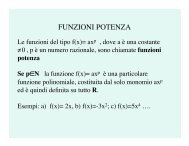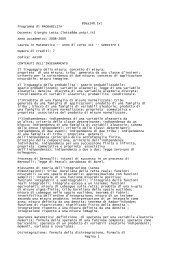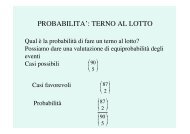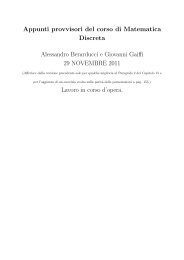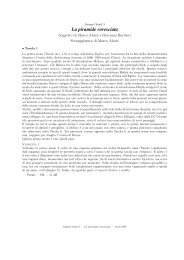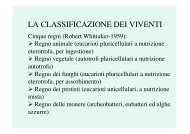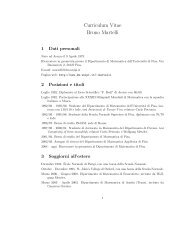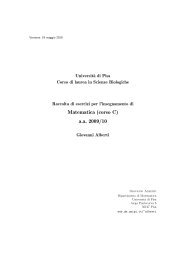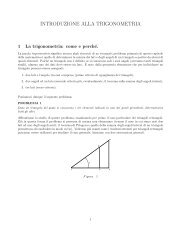Immersioni aperte in dimensione infinita - Dipartimento di Matematica
Immersioni aperte in dimensione infinita - Dipartimento di Matematica
Immersioni aperte in dimensione infinita - Dipartimento di Matematica
You also want an ePaper? Increase the reach of your titles
YUMPU automatically turns print PDFs into web optimized ePapers that Google loves.
34 Embedd<strong>in</strong>g aperti <strong>di</strong> varietà <strong>di</strong> <strong><strong>di</strong>mensione</strong> <strong>in</strong>f<strong>in</strong>ita<br />
particolare è cont<strong>in</strong>ua. Inf<strong>in</strong>e, per la proposizione C.29 pag. 73, Mn è una sottovarietà <strong>di</strong> M tale<br />
che <strong>di</strong>m Mn = <strong>in</strong>d (f) + <strong>di</strong>m Hn = 0 + n = n.<br />
Posta come nell’osservazione 2.35 f n := π n ◦ f, poiché f è trasversa a Hn segue che O è un<br />
valore regolare per fn, dunque, per ogni x <strong>in</strong> Mn, per il teorema C.27<br />
ker(π n ◦ dfx) = ker d(π n th −1<br />
) f(x) ◦ dfx = ker d(fn) x = Tx fn (O) = TxMn,<br />
<strong>in</strong> cui l’ultima uguaglianza è vera essendo<br />
f −1<br />
n (O) := (π n ◦ f) −1 (O) = f −1 ◦ (π n ) −1 (O) = f −1 (Hn) =: Mn.<br />
Inoltre, π n applica dfx(TxM) su H/Hn, <strong>in</strong>fatti f ⋔ Hn, dunque, essendo x <strong>in</strong> Mn, risulta che<br />
dfx(TxM) + Hn = H e qu<strong>in</strong><strong>di</strong> dfx(TxM) ⊃ H n . Il teorema <strong>di</strong> omomorfismo fornisce qu<strong>in</strong><strong>di</strong> un<br />
isomorfismo tra TxM/TxMn e H/Hn, isomorfismo che rende commutativo il seguente <strong>di</strong>agramma:<br />
TxM dfx <br />
<br />
TxM<br />
TxMn<br />
<br />
H<br />
<br />
πn <br />
<br />
<br />
<br />
<br />
<br />
<br />
<br />
Verifichiamo che M∞ := <br />
n∈N Mn è un denso <strong>di</strong> M. Innanzitutto ricor<strong>di</strong>amo che, essendo<br />
l’unione <br />
n∈N Hn densa <strong>in</strong> H, se F è un sottospazio chiuso <strong>di</strong> H <strong>di</strong> co<strong><strong>di</strong>mensione</strong> f<strong>in</strong>ita, <strong>in</strong> virtù<br />
del lemma 2.8 esiste n0 tale che n ≥ n0 ⇒ Hn + F = H. Sia x <strong>in</strong> M ed U ⊂ M un <strong>in</strong>torno aperto<br />
<strong>di</strong> x. Proveremo che U ∩ Mn = ∅ purché n sia grande abbastanza, da cui seguirà certamente la<br />
tesi. Per il teorema <strong>di</strong> rappresentazione locale [Ab-Ro 67] esiste un sotto<strong>in</strong>sieme aperto V ⊂ U ed<br />
un <strong>di</strong>ffeomorfismo<br />
α: V → V1 × V2 ⊂ F1 × F2 = H<br />
tale che per i = 1, 2 (a) Vi è una palla nel sottospazio Fi <strong>di</strong> H, <strong>in</strong> cui F1 ha <strong><strong>di</strong>mensione</strong> f<strong>in</strong>ita ed F2<br />
ha co<strong><strong>di</strong>mensione</strong> f<strong>in</strong>ita; (b) F2 = Im (dfx), α(x) = f(x); (c) f ◦ α−1 (x1, x2) = <br />
η(x1, x2), x2 .<br />
Sia n abbastanza grande <strong>in</strong> modo tale che Hn ∩ (V1 × V2) = ∅ e Hn + F2 = H. In<strong>di</strong>chiamo con<br />
F un complementare <strong>di</strong> Hn ∩ F2 <strong>in</strong> Hn. Possiamo trovare un <strong>di</strong>ffeomorfismo<br />
H<br />
Hn<br />
β : V → W1 × W2 ⊂ F × F2<br />
<strong>in</strong> modo tale che β(x) = f(x) e f ◦β −1 sia della forma f ◦β −1 (x1, x2) = <br />
¯η(x1, x2), x2 . Sia y2 ∈ W2<br />
tale che y2 ∈ Hn. Allora β−1 (y1, y2) ∈ Mn per ogni y1 <strong>in</strong> W1. Dunque U ∩ Mn = ∅.<br />
Osservazione 2.39. La <strong>di</strong>mostrazione appena conclusa resta immutata nella sostanza quando <strong>in</strong><br />
luogo <strong>di</strong> H si consideri uno spazio <strong>di</strong> Banach reale E <strong>di</strong> <strong><strong>di</strong>mensione</strong> <strong>in</strong>f<strong>in</strong>ita, dotato <strong>di</strong> una base <strong>di</strong><br />
Schauder e <strong>di</strong> partizioni dell’unità <strong>di</strong> classe C ∞ .<br />
Una filtrazione costruita come nel teorema precedente sarà detta anche una filtrazione <strong>di</strong> Fredholm.<br />
Teorema 2.40. Esiste una mappa <strong>di</strong> classe C ∞ , Fredholm <strong>di</strong> <strong>in</strong><strong>di</strong>ce zero, limitata e propria<br />
f : M → H trasversa ad Hn per ogni n <strong>in</strong> N. In particolare, tutte le sottovarietà Mn = f −1 (Hn)<br />
sono compatte.<br />
Dimostrazione. Per il corollario 2.34 sappiamo che una tale mappa f esiste, resta da <strong>di</strong>mostrare<br />
che le sottovarietà Mn sono compatte: poiché f è limitata si ha che f(M) ⊂ BO(R), ove BO(R)<br />
denota una palla chiusa <strong>di</strong> centro O e raggio R abbastanza grande, dunque, per ogni n<br />
Mn = f −1 (Hn) = f −1 Hn ∩ BO(R) .<br />
IMMERSIONI APERTE IN DIMENSIONE INFINITA


